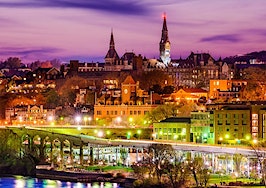- There are massive, empty streetcar tunnels under Dupont Circle.
- Numerous attempts to remake the space have failed over the years.
- Dupont Underground, an arts group, seeks to reuse the space creatively.
Above ground Dupont Circle is a thriving cultural gem in the heart of DC. One could spend a succession of afternoons and evenings enjoying the accessible and comfortable attractions that make a upwardly mobile neighborhood homey.
But below, a storied 75,000 square foot space stands vacant, a testament to DC history and valiant attempts to repurpose the uncommon cavern, located 25 feet beneath Dupont Circle.
Once twin streetcar tunnels that were home to a prior century’s transportation system, the caverns, which appear to be in surprisingly good shape, flank Connecticut Avenue. The tracks are still there. Some of the walls are tiled and ornately carved with monuments to a previous generation of Washingtonians.
[Tweet “From streetcars to art installations under Dupont Circle”]
But yet, remnants at past attempts at an adaptive reuse of the space still warn of the complicated path to a new life for the tunnels.
After a decade of appealing city leaders, the Dupont Underground, an arts group, in 2014 stepped up and inked a five-year deal on the space. For the bargain price of $30,000 a year, the group plans to breathe new life into the tunnels, reimagining them as a cultural hub.
What’s next for the Dupont Underground?
The master plan envisions the space as a concert venue, art gallery and public space for a variety of other uses. The planners have no shortage of challenges ahead of them: design challenges, waste disposal and utility issues all participated in the downfall of previous efforts.
The redevelopment attempts for the tunnels go back at least 60 years, with a trail of broken dreams left in their wake. It has largely sat fallow since a failed attempt, spearheaded by the Marion Barry administration, to become an underground food court saw its last tenant pack up shop.
That effort was dubbed Dupont Down Under, and saw the tunnel as a massive food court on its western platform. Sixteen streetcar-themed booths would serve a variety of fare in the unique space. Those developers also saw in its future a Laundromat, a newsstand and a grocery store.
Dupont Down Under launched to fanfare in 1995, and failed by 1996.
Prior to that attempt, the city had not entertained proposals from developers since 1982, and it took about a decade then for Mayor Barry to give the nod to Dupont Down Under. And, in the decades before, a list of potential reuses runs the gamut from the useful to the slightly macabre. Since the 60s, plans have been floated to turn the space into a fallout shelter, a gym, an underground shopping mall, and a storage facility for funeral urns.
From their inception, the tunnels were already remnants of a time in the history of transportation that was in decline. They first were brought on line in the late ‘40s as a relief options for the crowded commuter trolley line serving Connecticut Avenue. But by that time the rise of public buses and the automobile signaled a change in preferences that led to the demise of streetcar in 1962.
If you remember the National Building Museum’s ball pit exhibit from this past summer, you may wonder where all those plastic balls went after the installation closed last fall. At present, as Dupont Underground gains steam, the 750,000 plastic orbs fill part of the space. The balls are now part of a design competition, whose winner will repurpose them into an exhibit when the space opens in May.
Perhaps that will be the first of many successful examples of reimagining the underground space.




